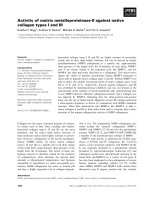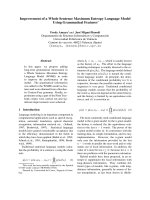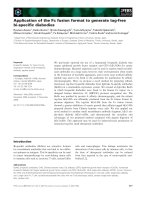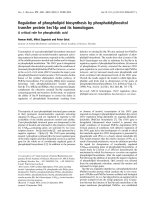báo cáo khoa học: "Application of in situ reverse trancriptase-polymerase chain reaction (RT-PCR) to tissue microarrays" pot
Bạn đang xem bản rút gọn của tài liệu. Xem và tải ngay bản đầy đủ của tài liệu tại đây (376.52 KB, 5 trang )
BioMed Central
Page 1 of 5
(page number not for citation purposes)
Journal of Nanobiotechnology
Open Access
Research
Application of in situ reverse trancriptase-polymerase chain
reaction (RT-PCR) to tissue microarrays
Alasdair C Stamps*, Jonathan A Terrett and Paul J Adam
Address: Oxford GlycoSciences (UK) Ltd., The Form, 86 Milton Park, Abingdon, UK OX14 4RY
Email: Alasdair C Stamps* - ; Jonathan A Terrett - ; Paul J Adam -
* Corresponding author
Abstract
Detection of disease-associated gene transcripts in primary disease tissues is frequently
confounded by the presence of non-involved cell types. Alternative methods of detecting gene
expression directly within tissues involve either the generation of antibodies, which can be a lengthy
process and may suffer from lack of specificity, or amplification of reverse-transcribed cDNA in
tissue sections (in situ RT-PCR). The latter method is highly specific and enables detection of
transcripts in the cells originally responsible for their synthesis, but is highly destructive of tissue
structures and can be carried out on only one or a few sections per experiment, resulting in low
reproducibility. In this study, in situ RT-PCR was applied for the first time to commercially available
tissue section microarrays enabling the examination of up to 70 different samples simultaneously.
Modifications to the technique are detailed that preserved visible tissue and cellular structures and
improved transcript detection whilst preventing significant generation of artefacts.
Background
Prior to the advent of miniaturisation, the study of cellular
gene expression took the form of either antibody-protein
detection, such as Western blotting of protein lysates or
immunohistochemistry (IHC) on tissue sections or im-
mobilised tissue culture cells, or nucleic acid analyses
such as Northern blot hybridisation of RNA transcripts or
PCR amplification of reverse-transcribed cDNA. Miniatur-
isation technologies are now long established in the meas-
urement of RNA expression levels, in the form of nucleic
acid microarray. Compared to classical Northern blotting
or even the small amounts of material required for PCR,
the microarray presents significant economies of scale and
can equal or better the specificity of other techniques, in-
cluding the detection of single nucleotide polymorphisms
and splice variants. High throughput is, however, expen-
sive, and particularly in clinical studies may not be practi-
cal from the point of view of sample sizes. Primary
samples are also heterogeneous and although microarray
and other techniques may reveal variations in gene expres-
sion, they do not identify the cell type responsible for the
differential. Although the use of antibodies in IHC has the
advantage of detecting in situ the protein product of gene
expression, the origin of secreted proteins such as growth
factors, cytokines and serum markers may not be revealed
by this technique. Miniaturisation of protein detection
has given rise to some notable technologies e.g. surface
plasmon resonance and emerging 'protein chip' plat-
forms. This area of development is less advanced than ge-
nomic microarray and faces greater challenges due to the
less predictable nature of protein interactions in solution,
and the greater difficulty in synthesising, and optimising
conditions for detection molecules.
The specific amplification of cytosolic mRNA molecules
in paraffin-embedded tissue sections was first reported by
Published: 28 May 2003
Journal of Nanobiotechnology 2003, 1:3
Received: 29 April 2003
Accepted: 28 May 2003
This article is available from: />© 2003 Stamps et al; licensee BioMed Central Ltd. This is an Open Access article: verbatim copying and redistribution of this article are permitted in all
media for any purpose, provided this notice is preserved along with the article's original URL.
Journal of Nanobiotechnology 2003, 1 />Page 2 of 5
(page number not for citation purposes)
Staecker et al. [1], using fluorescence detection of ampli-
fied molecules. Use of the technique is not as widespread
as other RT-PCR methods, however, and this may be due
to technical complexity and an inherent lack of reproduc-
ibility [2,3]. The processing of large numbers of samples is
also slow and sequential, adding to variability issues.
We present for the first time, the application of in situ RT-
PCR to the detection of specific RNA transcripts in histo-
logical microarrays of up to 250 different samples per
slide, using modifications of the procedure to maximise
reliability and sensitivity. The modified method may be
carried out entirely using commercially available materi-
als, including tissue microarrays.
Results
Real-time quantitative RT-PCR analysis of expression of
the extracellular matrix protein gene spondin 2 [4] was
carried out on a series of total RNA preparations from nor-
mal human tissue and paired normal/cancer samples. Se-
lection of sequences for oligonucleotide primers was
carried out with the aim of amplifying sequences that
spanned two or more exons, such that the intervening in-
trons in the corresponding genomic DNA would distance
the two primers beyond the capacity of the PCR method
to amplify. The DNA sequence of the spondin 2 gene was
downloaded from Ensembl [5] and primer sequences se-
lected from exon 4, nucleotides 3 to 25, and exon 6, nu-
cleotides 14 to 36, in order to generate a 300 base pair
(bp) PCR product from reverse transcribed spondin 2 cD-
NA. The same primer sites in the genomic DNA were sep-
arated by 3567 bp, preventing detectable amplification
from this source. Significant elevation of expression was
observed in prostate cancer compared to normal prostate
tissue and all other normal tissues tested (Figure 1). In the
same reactions, a pair of 'scrambled' primers, unrelated to
any known DNA sequence, yielded no amplification
products.
The same primers were used in in situ RT-PCR analysis of
1 mm paraffin-embedded tissue section arrays, as de-
scribed in Materials and Methods (Figure 2). Experience
with immunohistochemistry on tissue microarray showed
that sections on poly-L-lysine coated miroscope slides
Figure 1
Quantitative RT-PCR analysis of human primary normal and cancer tissues. Amplification of reverse-transcribed
mRNA was carried out on pools of normal human tissue as indicated and on a pool of prostate cancer samples, as described in
Methods, and measured by SYBR-green staining and fluorescence quantification. Results were calculated relative to a set of
standards and expressed here as copy number of original transcripts per ng of mRNA.
Journal of Nanobiotechnology 2003, 1 />Page 3 of 5
(page number not for citation purposes)
were less prone to detachment during processing, so these
were chosen for the in situ RT-PCR experiments. Whilst the
standard de-waxing step was carried out to remove the
embedding material, the extensive deoxyribonuclease
(DNAse) treatment step [6] was omitted in order to better
preserve structural features on the tissue sections. The
number of PCR cycles used was set at 20, within the linear
range of amplification defined by real-time quantitative
RT-PCR (data not shown). Depending on the density of
sections on the slide, up to 70 could be covered by a single
coverslip. Successful amplification was indicated by the
presence of silver grains visible under light microscopy
(Figure 3), whilst the hematoxylin counterstain highlight-
ed cell nuclei to provide a necessary distinction from the
cytoplasm, where all of the specific amplification oc-
curred. It was clear from the pattern of silver grains that
the increase in expression of spondin-2 at the transcrip-
tional level was confined to the cancer cells themselves,
which were distinguished by their large nuclei and disor-
ganised morphology. In control experiments using
'scrambled' primers in the place of spondin-2 specific oli-
gonucleotides, no amplification was observed.
Discussion
The use of in situ RT-PCR to examine gene expression in
disease tissues has certain advantages over more estab-
lished hybridisation, PCR amplification or antibody-
based techniques. As with immunohistochemistry, detec-
tion of gene expression is at the level of individual cells
[7], but whereas polyclonal antibody production by im-
munisation may take 4 months or longer, and require ex-
tensive optimisation, it is relatively easy to characterise
and optimise oligonucleotide primers which have
Figure 2
Flow chart describing the application of in situ RT-
PCR to tissue microarrays. Step 1: Slide preparation. Sec-
tions were deparaffinated by xylene washes, and celluar
material permeabilised by limited proteinase K digestion;
Step 2: amplification of reverse-transcribed cDNA using
intron-spanning PCR primers (horizontal arrows) added in a
single mix of reverse transcriptase, rTth polymerase and
deoxyribonucleotides spiked with digoxygenin-labelled dUTP
(black ovals); Step 3: visualisation of PCR products by binding
to digoxygenin-specific gold-labelled antibodies (yellow dots),
followed by silver nucleation around the bound gold particles
(grey crescents).
Figure 3
In situ RT-PCR analysis of tissue microarrays. Slides
containing up to 250 sections of 1 mm diameter, taken from
prostate cancer biopsies, were subjected to in situ RT-PCR as
described in Methods, using either spondin-2-specific oligo-
nucleotide primers (i) or control 'scrambled' primers (ii).
PCR prodcts were labelled by Immunogold with silver
enhancement; after hematoxylin staining to highlight cell
nuclei (n), sections were visualised by light microscopy at
40× magnification.
Journal of Nanobiotechnology 2003, 1 />Page 4 of 5
(page number not for citation purposes)
considerably less chemical complexity and, therefore, in-
herently more predictable properties. Moreover, while
cross-reactivity is a frequent problem when selecting anti-
bodies for protein detection, it is a simple matter to select
PCR primers that are specific to a single member of a gene
family, or even a particular splice variant of that gene.
We have successfully applied in situ RT-PCR to 1 mm par-
affin-embedded tissue section arrays in order to deter-
mine which cells within a cancer are responsible for gene
over-expression observed in RNA extracts. A number of
technical manipulations were incorporated into the in
situ protocol to ensure specificity and fidelity, and these
transferred readily to the micro-array format. To our
knowledge, this is the first time this procedure has been
applied simultaneously to multiple samples in a microar-
ray format.
A DNAse digestion step is commonly used in RT-PCR am-
plification in order to reduce the risk of spurious amplifi-
cation of genomic DNA [8–10]. This can also be carried
out on tissue sections [6] but the extensive incubation
time required (up to 16 hr) means that considerable tissue
autolysis occurs, damaging tissue structure and making
post-PCR identification of cells difficult. In our protocol,
the DNAse digestion step was omitted so as to better pre-
serve tissue structure. Modifications to experimental de-
sign were employed to prevent amplification of genomic
DNA. Although other approaches have been taken to ob-
viate nuclease pre-treatment [11], we employed more con-
ventional means. Firstly, primers were designed to
amplify across two different exons, so that the amplified
fragment from reverse transcribed, fully spliced mRNA
would be small (300 bp), whilst the distance between the
same primer sites in genomic DNA was over 3500 bp. Sec-
ondly, the number of PCR cycles and the duration of the
polymerisation step were minimised so that any priming
from genomic DNA would fail to achieve chain-reaction
amplification. These strategies had a number of other ben-
eficial effects: the PCR cycle number was kept with the lin-
ear range of amplification established by real-time
quantitative RT-PCR, giving a more quantitative represen-
tation of the mRNA remaining in each cell, and avoiding
significant synthesis of non-specific artifacts. Diffusion of
reaction products away from the site of synthesis, another
problem associated with in situ PCR [12], was reduced by
this rapid procedure and exposure of the tissue sections to
destructive conditions was also minimised, with the result
that post-amplification staining revealed a high degree of
preservation of tissue architecture and cellular features.
A consequence of using low PCR cycle numbers is that the
degree of amplification will be limited, with implications
for detection of the PCR product. Standard peroxidase-
linked antibody detection is insufficiently sensitive.
Chemiluminescent or fluorescent detection reagents
could be used instead to amplify the signal, but these
would require specialised image detection systems and
would rapidly diffuse away from the point of detection.
Immunogold labelling followed by silver nucleation pro-
duced solid particles visible by light microscopy at magni-
fications suitable for visualising tissue and cellular
features. This enabled simultaneous imaging of PCR prod-
ucts and hematoxylin-stained tissue details. The silver par-
ticles were bound to PCR products via anti-digoxygenin
antibodies, and proved resistant to diffusion, remaining
in the same cellular localisation as the original mRNA.
A persistent problem with the in situ PCR procedure has
been inconsistency of results. Dedicated instrumentation
has been designed with the aim of controlling conditions
on a microscope slide, and some machines accommodate
four or more slides to increase throughput and lower ex-
perimental variability. However, variation in the quality
of paraffin-embedded tissue sections, and the number of
steps involved in in situ PCR and the time taken to acquire
data on significant numbers of samples affect the repro-
ducibility of the technique. We found that a single, stand-
ard in situ PCR coverslip covered up to seventy 1 mm
sections on a Clinomics tissue microarray, enabling si-
multaneous amplification of reverse transcribed RNA in
each section under selected conditions. Although small
tissue sections are more likely to become dislodged during
the process of de-waxing and amplification, the use of
poly-L-lysine coated slides decreased these losses and the
cancer tissues examined were intrinsically more adherent
due to their high cellularity. Thus a significant number of
tissue samples could be analysed per single experiment.
This approach substantially addresses the problem of
slide-to-slide variability by subjecting large numbers of
samples to identical experimental conditions. In addition,
our technical modifications minimised tissue damage
during preparation and amplification, preserving useful
information on cellular morphology.
Conclusions
In situ PCR can be successfully applied to tissue microar-
rays for the specific detection and cellular localisation of
transcriptional expression. The analysis of up to 70 sec-
tions in a single amplification experiment addresses the
problem of experimental variability associated with this
method. Modifications were introduced into the proce-
dure aimed at reducing sample degradation, resulting in
preservation of tissue and subcellular structures and re-
ducing diffusion of labelled PCR products. Methods were
carried out using entirely commercially available reagents,
in order to develop a standardised procedure for visualisa-
tion of mRNA expression in situ.
Journal of Nanobiotechnology 2003, 1 />Page 5 of 5
(page number not for citation purposes)
Methods
Quantitative Reverse Transcriptase-Polymerase Chain Re-
action (RT-PCR)
Real-time quantitative RT-PCR analysis of gene expression
[13,14] was carried out on first-strand cDNA derived from
RNA isolated from samples of normal and tumour tissues.
Each PCR reaction contained 10 ng first-strand cDNA
(prepared from each mRNA sample using SuperscriptTM
reverse transcriptase, Life Technologies, Carlsbad, CA),
SYBR green sequence detection reagents (Applied Biosys-
tems, Foster City, CA), and sense and anti-sense primers.
The primers used to amplify spondin-2 were: sense, 5'-
CTCGTTTGTGGTGCGCATCGTG-3'; antisense, 5'-CAG-
GGAGACCTCGCAGTCCAGC-3'. The thermal cycling pa-
rameters were; 1 cycle of 94°C for 2.5 minutes followed
by 40 cycles of 94°C for 40 seconds, 60°C for 50 seconds,
72°C for 30 seconds. Real-time quantitative RT-PCR was
assayed on an ABI Prism 7700 sequence detection system
(Applied Biosystems, Foster City, CA) and the accumula-
tion of PCR product was measured in real time as the in-
crease in SYBR green fluorescence. Data was analyzed
using the Sequence Detector program v1.6.3 (Applied Bi-
osystems, Foster City, CA). Standard curves relating initial
template copy number to fluorescence and amplification
cycle were generated using the amplified PCR product as
a template, and were used to calculate mRNA copy
number in each sample. Data were expressed as relative
mRNA expression.
In Situ RT-PCR
Direct in situ RT-PCR detection of spondin-2 mRNA ex-
pression was examined in formalin fixed, paraffin embed-
ded prostate cancer tissues (Clinomics Biosciences, Inc.,
Frederick, MD), arranged on microscope slides in arrays of
up to 250 sections, each 1 mm in diameter. The tissue was
de-waxed in xylene, gradually re-hydrated through alco-
hol and washed in phosphate buffered saline (PBS) before
being permeabilised in 0.01% Triton X-100 for 3 minutes
followed by treatment with Proteinase K for 30 minutes at
37°C. Direct in situ RT-PCR was carried out in a GeneAmp
In Situ PCR System 1000 (Perkin Elmer Biosystems, Foster
City, CA) using a GeneAmp Thermostable rTth RT-PCR kit
(Perkin Elmer Biosystems, Foster City, CA). In addition to
the spondin-2 specific primers described above, the fol-
lowing 'scrambled' primers were used for control amplifi-
cations: 5'-GTTGCGATCGTGCTGTGCGTCT-3'; 5'-
CGACGCTAGCTCAGCACGCGAG-3'. The thermal cy-
cling parameters were; 1 cycle of 94°C for 2.5 minutes fol-
lowed by 20 cycles of 94°C for 40 seconds, 60°C for 50
seconds, 72°C for 30 seconds. Amplified product was de-
tectable through the direct incorporation of alkali stable
digoxigenin-11-deoxyuridine triphosphate (dUTP; Roche
Diagnostics Ltd., Basel, Switzerland) which was added to
the reaction mix according to the manufacturer's recom-
mendation. After washing in PBS, 10 ul Anti-Digoxigenin-
Gold antibody (Roche Diagnostics Ltd., Basel, Switzer-
land), diluted 1:30 in PBS and bovine serum albumin
(BSA, Sigma, Dorset, UK) (1 mg BSA/1 ml PBS) was incu-
bated on the tissue section for 30 minutes at room tem-
perature, washed once in PBS then five times in deionised
water to remove all traces of ions. 100 ul freshly prepared
silver enhancement reagents (Roche Diagnostics Ltd., Ba-
sel, Switzerland) were applied to the immunogold-la-
belled slide and incubated for thirty minutes. The tissue
was counter-stained with hematoxylin (Dako Ltd., Glos-
trup, Denmark) and images were captured by a digital
camera attached to a light microscope.
References
1. Staecker H, Cammer M, Rubinstein R and Van de Water TR A pro-
cedure for RT-PCR amplification of mRNAs on histological
specimens Biotechniques 1994, 16:76-80
2. Steel JH, Morgan DE and Poulsom R Advantages of in situ hybrid-
isation over direct or indirect in situ reverse transcriptase-
polymerase chain reaction for localisation of galanin mRNA
expression in rat small intestine and pituitary Histochem J 2001,
33:201-211
3. Nuovo GJ Co-labeling using in situ PCR: a review J Histochem
Cytochem 2001, 49:1329-39
4. Manda R, Kohno T, Matsuno Y, Takenoshita S, Kuwano H and Yokota
J Identification of genes (SPON2 and C20orf2) differentially
expressed between cancerous and noncancerous lung cells
by mRNA differential display Genomics 1999, 61:5-14
5. Ensembl [ />script=ENST00000290902&db=core]
6. Komminoth P and Long AA In-situ polymerase chain reaction.
An overview of methods, applications and limitations of a
new molecular technique Virchows Arch B Cell Pathol Incl Mol Pathol
1993, 64:67-73
7. Osada T, Uehara H, Kim H and Ikai A mRNA analysis of single liv-
ing cells J Nanobiotechnology 2003, 1:2
8. Grillo M and Margolis FL Use of reverse transcriptase polymer-
ase chain reaction to monitor expression of intronless genes
Biotechniques 1990, 262, 264:266-268
9. Lau GK, Fang JW, Wu PC, Davis GL and Lau JY Detection of hep-
atitis C virus genome in formalin-fixed paraffin-embedded
liver tissue by in situ reverse transcription polymerase chain
reaction J Med Virol 1994, 44:406-409
10. Martinez A, Miller MJ, Quinn K, Unsworth EJ, Ebina M and Cuttitta F
Non-radioactive localization of nucleic acids by direct in situ
PCR and in situ RT-PCR in paraffin-embedded sections J His-
tochem Cytochem 1995, 43:739-747
11. Menschikowski M, Vogel M, Eckey R, Dinnebier G and Jaross W In
situ reverse transcriptase-nested polymerase chain reaction
to identify intracellular nucleic acids without the necessity of
DNAse pretreatment and hybridisation Anal Cell Pathol 2001,
22:151-158
12. Teo IA and Shaunak S Polymerase chain reaction in situ: an ap-
praisal of an emerging technique Histochem J 1995, 27:647-59
13. Heid CA, Stevens J, Livak KJ and Williams PM Real time quantita-
tive PCR Genome Res 1996, 6:986-994
14. Morrison TB, Weis JJ and Wittwer CT Quantification of low-copy
transcripts by continuous SYBR Green I monitoring during
amplification Biotechniques 1998, 24:954-958









